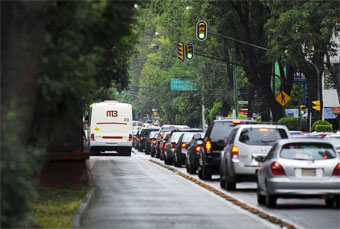Sadik-Khan: NYC Will Try Out Bolder Bus Improvements, But Not Now
With the redesign of First and Second Avenues moving through the public review process, hundreds of regional transportation experts gathered at an NYU conference today to discuss the future of bus rapid transit in the New York region. Representatives from NYCDOT, the MTA, and the federal government all envisioned BRT as part of New York’s transit future and gave a few hints as to what might come next.
 DOT commish Janette Sadik-Khan showed this slide while saying that her agency hopes to "play around with the right-of-way more" in future bus projects.
DOT commish Janette Sadik-Khan showed this slide while saying that her agency hopes to "play around with the right-of-way more" in future bus projects. Transportation Commissioner Janette Sadik-Khan admitted that New York has only taken incremental steps toward implementing a high-quality bus rapid transit system so far. "There are some people who think we should become Curitiba-on-the-Hudson overnight," she said, "but that takes more time, more money, and more right-of-way than we have right now."
At the same time, Sadik-Khan promised that the current Select Bus Service configurations aren’t the final word in BRT design for New York City. "In the future, we’re hoping to play around with the right-of-way more," she said, switching to a slide of a physically separated bus lane.
Regarding Select Bus Service along First and Second Avenues, Sadik-Khan argued that the site wasn’t appropriate for a move as bold as separated bus lanes. "Moving forward, we’re going to experiment," she said, "but we’re not going to experiment on 250 block faces on Manhattan’s East Side." Apparently, New York will have to wait for world-class BRT.
One of the conference panelists revealed a possible route for a future BRT project. William Wheeler, the director of special project development and planning for the MTA, announced that "at some point in the future, I really hope we can look at Queens Boulevard" for a BRT route.
Any future BRT routes in New York City will likely have backing from the feds. Therese McMillan, the deputy administrator at the Federal Transit Administration, closed her remarks by saying that she was there "to offer [the FTA’s] support in helping you with your next steps." FTA funding for Select Bus Service on Nostrand Avenue was announced earlier this month.
While New York has yet to commit to physically separated bus lanes, its rapid bus routes are more full-featured than those of other American transit systems, several of which had representatives speak at the conference. On the Metro Rapid service in Los Angeles, buses operate in mixed traffic and the stations don’t have pre-boarding fare payment. The Washington DC region is only giving buses dedicated space at the approach to intersections, not along entire routes.
On quantity, however, these cities have NYC beat. Even without dedicated lanes or pre-boarding fares, Los Angeles’s 27 rapid routes are moving 23 percent faster and drawing between 12 and 49 percent more riders than the routes they replaced. Washington has received funding for more than a dozen
so-called priority bus routes. New York, in contrast, is planning to roll out five rapid bus routes by 2012.